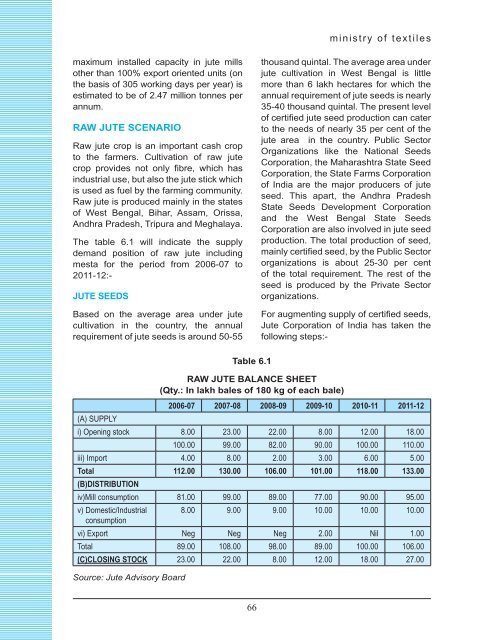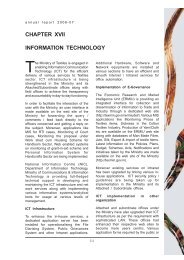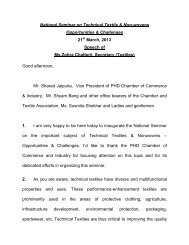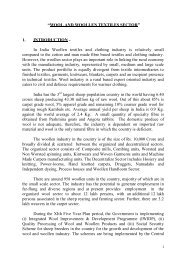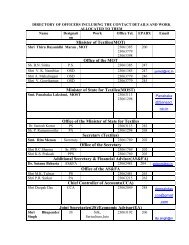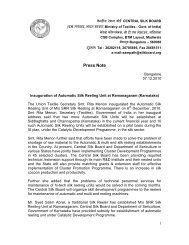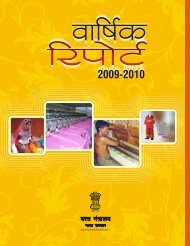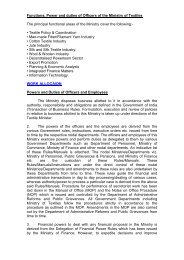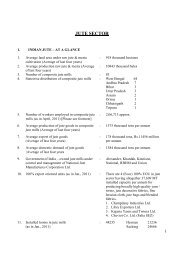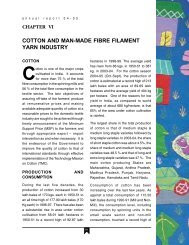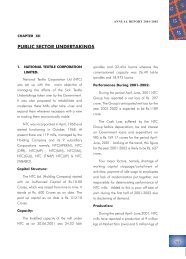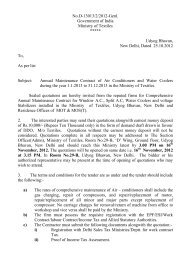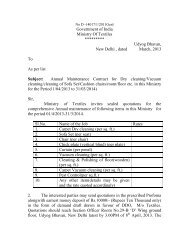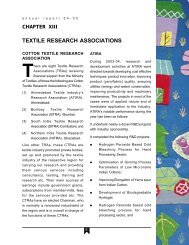chapter viii wool & wollen textiles industry - Ministry of Textiles
chapter viii wool & wollen textiles industry - Ministry of Textiles
chapter viii wool & wollen textiles industry - Ministry of Textiles
Create successful ePaper yourself
Turn your PDF publications into a flip-book with our unique Google optimized e-Paper software.
ministry <strong>of</strong> <strong>textiles</strong><br />
maximum installed capacity in jute mills<br />
other than 100% export oriented units (on<br />
the basis <strong>of</strong> 305 working days per year) is<br />
estimated to be <strong>of</strong> 2.47 million tonnes per<br />
annum.<br />
RAW JUTE SCENARIO<br />
Raw jute crop is an important cash crop<br />
to the farmers. Cultivation <strong>of</strong> raw jute<br />
crop provides not only fibre, which has<br />
industrial use, but also the jute stick which<br />
is used as fuel by the farming community.<br />
Raw jute is produced mainly in the states<br />
<strong>of</strong> West Bengal, Bihar, Assam, Orissa,<br />
Andhra Pradesh, Tripura and Meghalaya.<br />
The table 6.1 will indicate the supply<br />
demand position <strong>of</strong> raw jute including<br />
mesta for the period from 2006-07 to<br />
2011-12:-<br />
JUTE SEEDS<br />
Based on the average area under jute<br />
cultivation in the country, the annual<br />
requirement <strong>of</strong> jute seeds is around 50-55<br />
thousand quintal. The average area under<br />
jute cultivation in West Bengal is little<br />
more than 6 lakh hectares for which the<br />
annual requirement <strong>of</strong> jute seeds is nearly<br />
35-40 thousand quintal. The present level<br />
<strong>of</strong> certified jute seed production can cater<br />
to the needs <strong>of</strong> nearly 35 per cent <strong>of</strong> the<br />
jute area in the country. Public Sector<br />
Organizations like the National Seeds<br />
Corporation, the Maharashtra State Seed<br />
Corporation, the State Farms Corporation<br />
<strong>of</strong> India are the major producers <strong>of</strong> jute<br />
seed. This apart, the Andhra Pradesh<br />
State Seeds Development Corporation<br />
and the West Bengal State Seeds<br />
Corporation are also involved in jute seed<br />
production. The total production <strong>of</strong> seed,<br />
mainly certified seed, by the Public Sector<br />
organizations is about 25-30 per cent<br />
<strong>of</strong> the total requirement. The rest <strong>of</strong> the<br />
seed is produced by the Private Sector<br />
organizations.<br />
For augmenting supply <strong>of</strong> certified seeds,<br />
Jute Corporation <strong>of</strong> India has taken the<br />
following steps:-<br />
Table 6.1<br />
RAW JUTE BALANCE SHEET<br />
(Qty.: In lakh bales <strong>of</strong> 180 kg <strong>of</strong> each bale)<br />
2006-07 2007-08 2008-09 2009-10 2010-11 2011-12<br />
(A) SUPPLY<br />
i) Opening stock 8.00 23.00 22.00 8.00 12.00 18.00<br />
100.00 99.00 82.00 90.00 100.00 110.00<br />
iii) Import 4.00 8.00 2.00 3.00 6.00 5.00<br />
Total 112.00 130.00 106.00 101.00 118.00 133.00<br />
(B)DISTRIBUTION<br />
iv)Mill consumption 81.00 99.00 89.00 77.00 90.00 95.00<br />
v) Domestic/Industrial 8.00 9.00 9.00 10.00 10.00 10.00<br />
consumption<br />
vi) Export Neg Neg Neg 2.00 Nil 1.00<br />
Total 89.00 108.00 98.00 89.00 100.00 106.00<br />
(C)CLOSING STOCK 23.00 22.00 8.00 12.00 18.00 27.00<br />
Source: Jute Advisory Board<br />
66


